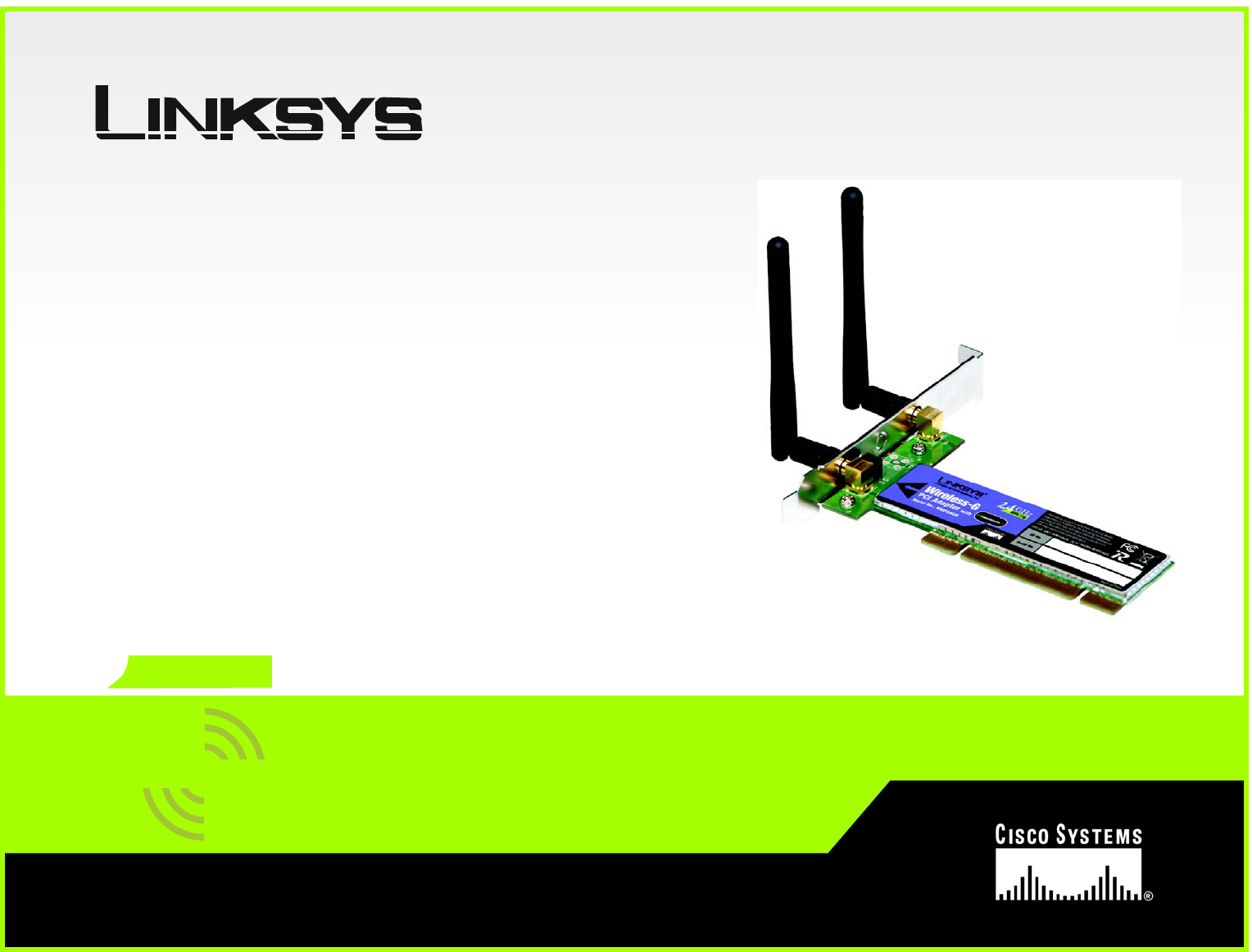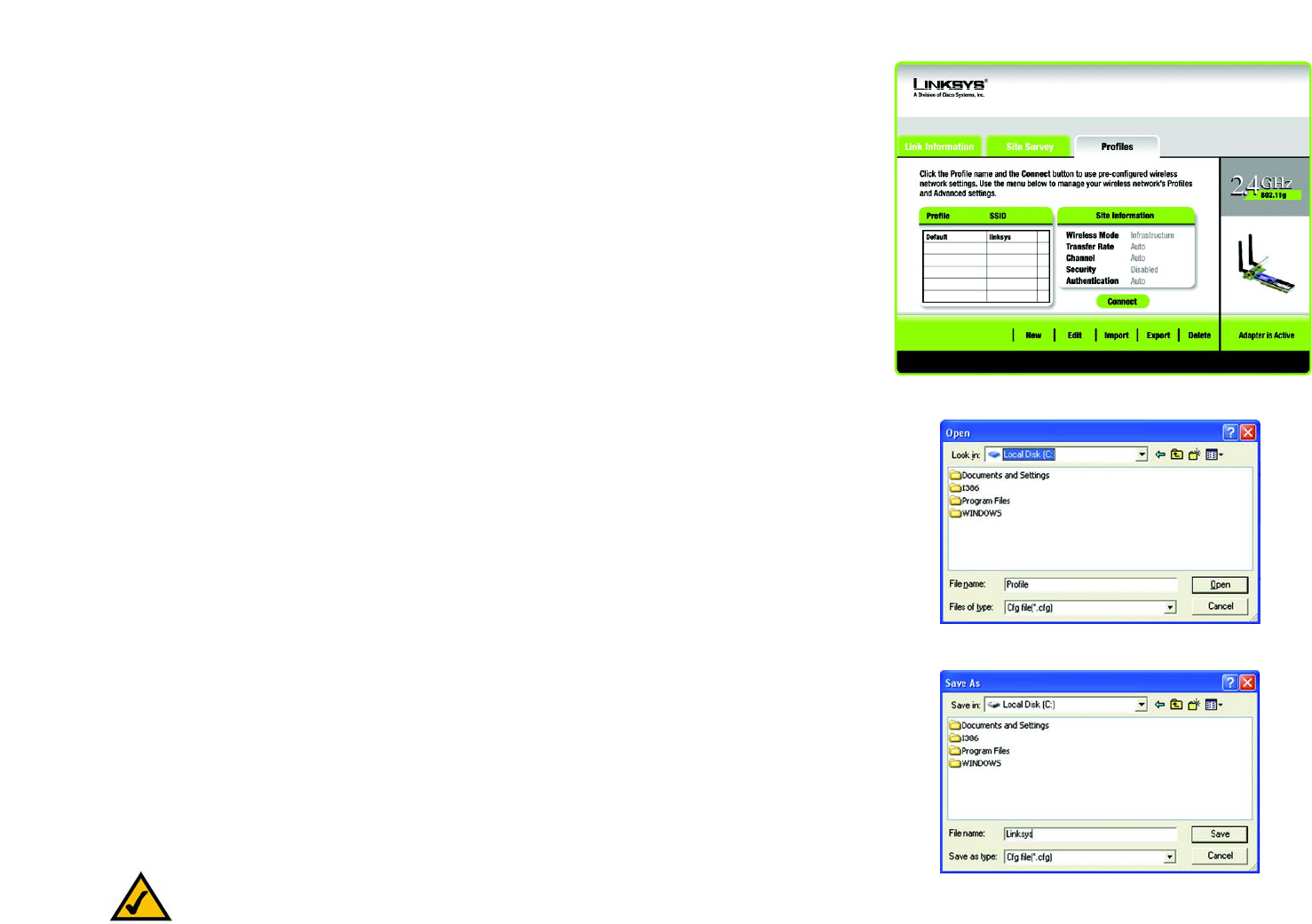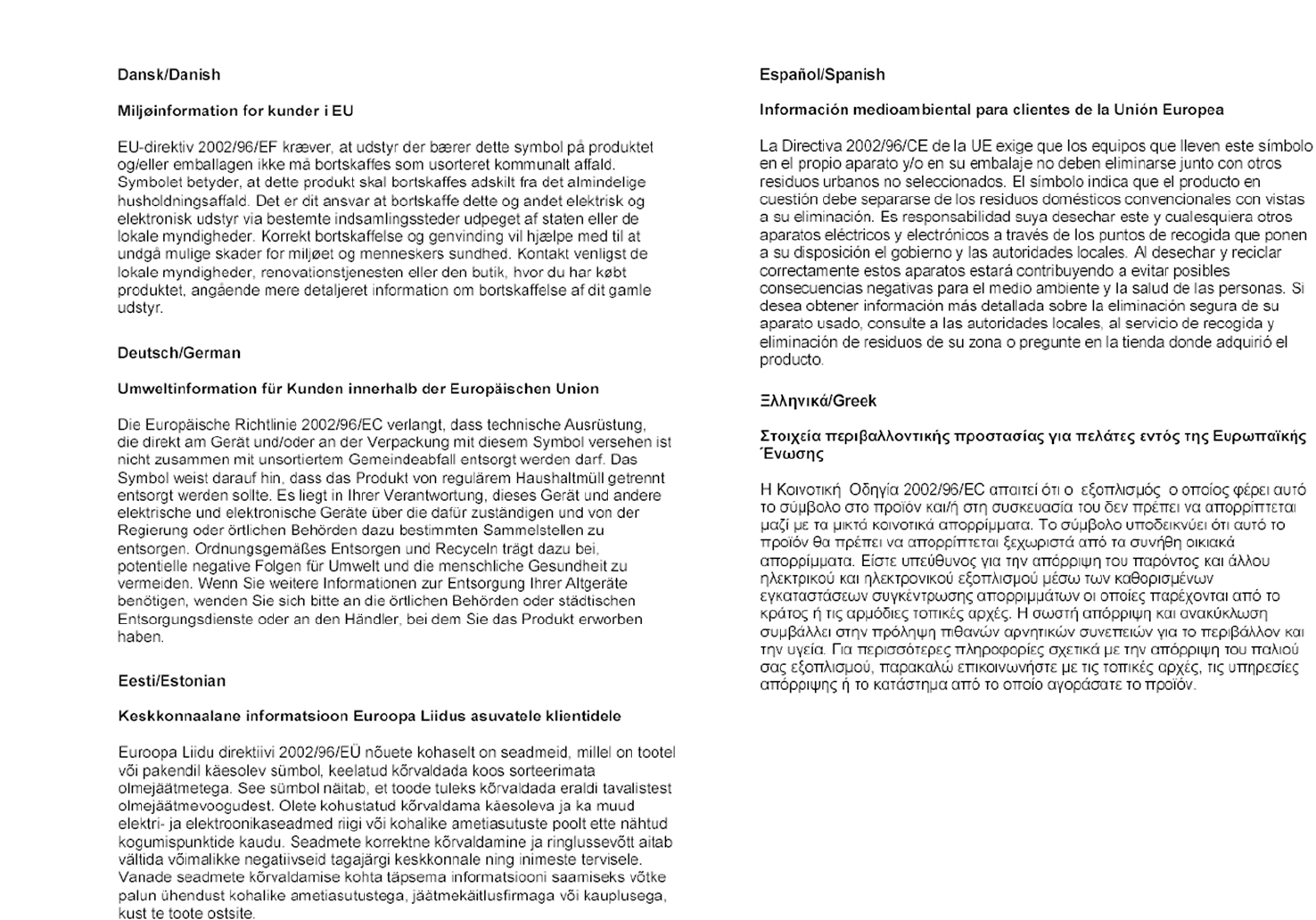LINKSYS WMP54GR Wireless-G PCI Adapter with RangeBooster User Manual Book
LINKSYS LLC Wireless-G PCI Adapter with RangeBooster Book
LINKSYS >
Manual

A Division of Cisco Systems, Inc.
®
Model No.
PCI Adapter
Wireless-G
WMP54GR
User Guide
WIRELESS
GHz
2.4
802.11g
with RangeBooster

Wireless-G PCI Adapter with RangeBooster
Copyright and Trademarks
Specifications are subject to change without notice. Linksys is a registered trademark or trademark of Cisco
Systems, Inc. and/or its affiliates in the U.S. and certain other countries. Copyright © 2006 Cisco Systems, Inc. All
rights reserved. Other brands and product names are trademarks or registered trademarks of their respective
holders.
How to Use This User Guide
This User Guide has been designed to make understanding networking with the Wireless-G PCI Adapter with
RangeBooster easier than ever. Look for the following items when reading this User Guide:
In addition to these symbols, there are definitions for technical terms that are presented like this:
Also, each figure (diagram, screenshot, or other image) is provided with a figure number and description, like
this:
Figure numbers and descriptions can also be found in the “List of Figures” section in the “Table of Contents”.
This exclamation point means there is a caution or warning and is something that
could damage your property or the Wireless-G PCI Adapter with RangeBooster.
This checkmark means there is a note of interest and is something you should pay
special attention to while using the Wireless-G PCI Adapter with RangeBooster.
This question mark provides you with a reminder about something you might need to
do while using the Wireless-G PCI Adapter with RangeBooster.
word: definition.
Figure 0-1: Sample Figure Description
WMP54GR-UG-51219NC BW
WARNING: This product contains chemicals, including lead, known
to the State of California to cause cancer, and birth defects or other
reproductive harm. Wash hands after handling.

Wireless-G PCI Adapter with RangeBooster
Table of Contents
Chapter 1: Introduction 1
Welcome 1
What’s in this Guide? 2
Chapter 2: Planning your Wireless Network 4
Network Topology 4
Roaming 4
Network Layout 5
Chapter 3: Setting up and Connecting the Wireless-G PCI Adapter with RangeBooster 6
Starting the Setup 6
Connecting the Adapter 7
Setting up the Adapter 7
Chapter 4: Using the Wireless Network Monitor 16
Accessing the Wireless Network Monitor 16
Using the Wireless Network Monitor 16
Link Information 16
Site Survey 19
Profiles 20
Create a New Profile 21
Appendix A: Troubleshooting 30
Common Problems and Solutions 30
Frequently Asked Questions 31
Chapter B: Using Windows XP Wireless Configuration 34
Appendix C: Wireless Security 37
Security Precautions 37
Security Threats Facing Wireless Networks 37
Appendix D: Windows Help 40
Appendix E: Glossary 41
Appendix F: Specifications 44
Appendix G: Warranty Information 46
Appendix H: Regulatory Information 47
Appendix I: Contact Information 53

Wireless-G PCI Adapter with RangeBooster
List of Figures
Figure 3-1: Setup Wizard’s Welcome Screen 6
Figure 3-2: Setup Wizard’s License Agreement 6
Figure 3-3: Connecting the Adapter 7
Figure 3-4: Available Wireless Network 7
Figure 3-5: WEP Key Needed for Connection 8
Figure 3-6: WPA - Personal Needed for Connection 8
Figure 3-7: PSK2 Needed for Connection 9
Figure 3-8: Congratulations 9
Figure 3-9: Available Wireless Network 10
Figure 3-10: Network Settings 10
Figure 3-11: Wireless Mode 10
Figure 3-12: Ad-Hoc Mode Settings 11
Figure 3-13: Wireless Security - WEP 11
Figure 3-14: Wireless Security - WPA Personal 12
Figure 3-1: Wireless Security - PSK2 12
Figure 3-15: Wireless Security - WPA Enterprise - EAP-TLS 13
Figure 3-16: Wireless Security - WPA Enterprise - PEAP 13
Figure 3-17: Wireless Security - RADIUS - EAP-TLS 14
Figure 3-18: Wireless Security - RADIUS - PEAP 14
Figure 3-19: Confirm New Settings 15
Figure 3-20: Congratulations screen 15
Figure 4-1: Wireless Network Monitor Icon 16
Figure 4-2: Link Information 16
Figure 4-3: More Information - Wireless Network Status 17
Figure 4-4: More Information-Network Statistics 18
Figure 4-5: Site Survey 18
Figure 4-6: WEP Key Needed for Connection 19
Figure 4-7: WPA-Personal Needed for Connection 19
Figure 4-8: PSK2 Needed for Connection 19
Figure 4-9: Profiles 20

Wireless-G PCI Adapter with RangeBooster
Figure 4-10: Import a Profile 20
Figure 4-11: Export a Profile 20
Figure 4-12: Create a New Profile 21
Figure 4-1: WEP Key Needed for Connection 21
Figure 4-2: WPA - Personal Needed for Connection 22
Figure 4-3: PSK2 Needed for Connection 22
Figure 4-4: Congratulations 22
Figure 4-13: Available Wireless Network 23
Figure 4-14: Network Settings 23
Figure 4-15: Wireless Mode 24
Figure 4-16: Ad-Hoc Mode Settings 24
Figure 4-17: Wireless Security - WEP 25
Figure 4-18: Wireless Security - WPA Personal 25
Figure 4-19: Wireless Security - PSK2 26
Figure 4-20: Wireless Security - WPA Enterprise Using EAP-TLS 27
Figure 4-21: Wireless Security - WPA Enterprise Using PEAP 27
Figure 4-22: Wireless Security - RADIUS Using EAP-TLS 28
Figure 4-23: Wireless Security - RADIUS Using PEAP 28
Figure 4-24: Confirm New Settings for New Profile 29
Figure 4-25: Congratulations 29
Figure B-1: Wireless Network Monitor Icon 34
Figure B-2: Windows XP - Use Windows XP Wireless Configuration 34
Figure B-3: Windows XP Wireless Configuration Icon 34
Figure B-4: Available Wireless Network 35
Figure B-5: No Wireless Security 35
Figure B-6: Network Connection - Wireless Security 36
Figure B-7: Wireless Network Connection 36

1
Chapter 1: Introduction
Welcome
Wireless-G PCI Adapter with RangeBooster
Chapter 1: Introduction
Welcome
Thank you for choosing the Wireless-G PCI Adapter with RangeBooster. With this Adapter, your wireless
networking experience will be faster and easier than ever.
How does the Adapter do this? Like all wireless products, the Adapter allows for greater range and mobility
within your wireless network. And with RangeBooster, the range and speed will be even greater. This adapter
communicates over the 54Mbps 802.11g wireless standard, but can also communicate with the widely used
11Mbps 802.11b standard.
But what does all of this mean? Networks are useful tools for sharing computer resources. You can access one
printer from different computers and access data located on another computer's hard drive. Networks are even
used for playing multiplayer video games. So, networks are not only useful in homes and offices, they can also be
fun.
PCs equipped with wireless cards and adapters can communicate without cumbersome cables. By sharing the
same wireless settings, within their transmission radius, they form a wireless network.
Use the instructions in this Guide to help you connect the Adapter, set it up, and configure it for your network.
These instructions should be all you need to get the most out of the Adapter.
802.11b: an IEEE wireless networking standard
that specifies a maximum data transfer rate of
11Mbps and an operating frequency of 2.4GHz
adapter: a device that adds network functionality
to your PC.
network: a series of computers or devices
connected for the purpose of data sharing,
storage, and/or transmission between users.
802.11g an IEEE wireless networking standard
that specifies a maximum data transfer rate of
54Mbps, an operating frequency of 2.4GHz, and
backward compatibility with 802.11b devices.
Mbps: one million bits per second; a unit of
measurement for data transmission

2
Chapter 1: Introduction
What’s in this Guide?
Wireless-G PCI Adapter with RangeBooster
What’s in this Guide?
This user guide covers the steps for setting up and using the Wireless-G PCI Adapter with RangeBooster.
• Chapter 1: Introduction
This chapter describes the Adapter’s applications and this User Guide.
• Chapter 2: Planning Your Wireless Network
This chapter discusses a few of the basics about wireless networking.
• Chapter 3: Setting Up and Connecting the PCI Adapter
This chapter shows you how to setup and connect the Adapter.
• Chapter 4: Using the Wireless Network Monitor
This chapter show you how to use the Adapter’s Wireless Network Monitor.
• Appendix A: Troubleshooting
This appendix describes some problems and solutions, as well as frequently asked questions, regarding
installation and use of the Adapter.
• Appendix B: Windows XP Wireless Zero Configuration
This chapter instructs you on how to install Window XP Wireless Zero Configuration
• Appendix C: Wireless Security
This appendix discusses security issues regarding wireless networking and measures you can take to help
protect your wireless network.
• Appendix D: Windows Help
This appendix describes how you can use Windows Help for instructions about networking, such as installing
the TCP/IP protocol.
• Appendix E: Glossary
This appendix gives a brief glossary of terms frequently used in networking.
• Appendix F: Specifications
This appendix provides the Adapter’s technical specifications.
• Appendix G: Warranty Information
This appendix supplies the Adapter’s warranty information.
• Appendix H: Regulatory Information
This appendix supplies the Adapter’s regulatory information.

3
Chapter 1: Introduction
What’s in this Guide?
Wireless-G PCI Adapter with RangeBooster
• Appendix I: Contact Information
This appendix provides contact information for a variety of Linksys resources, including Technical Support.

4
Chapter 2: Planning your Wireless Network
Network Topology
Wireless-G PCI Adapter with RangeBooster
Chapter 2: Planning your Wireless Network
Network Topology
A wireless network is a group of computers, each equipped with one wireless adapter. Computers in a wireless
network must be configured to share the same radio channel. Several PCs equipped with wireless cards or
adapters can communicate with one another to form an ad-hoc network.
Linksys wireless adapters also provide users access to a wired network when using an access point or wireless
router. An integrated wireless and wired network is called an infrastructure network. Each wireless PC in an
infrastructure network can talk to any computer in a wired network infrastructure via the access point or wireless
router.
An infrastructure configuration extends the accessibility of a wireless PC to a wired network, and can double the
effective wireless transmission range for two wireless adapter PCs. Since an access point is able to forward data
within a network, the effective transmission range in an infrastructure network can be doubled.
Roaming
Infrastructure mode also supports roaming capabilities for mobile users. Roaming means that you can move your
wireless PC within your network and the access points will pick up the wireless PC's signal, providing that they
both share the same channel and SSID.
Before enabling you consider roaming, choose a feasible radio channel and optimum access point position.
Proper access point positioning combined with a clear radio signal will greatly enhance performance.
infrastructure: a wireless network that is bridged
to a wired network via an access point.
ad-hoc: a group of wireless devices
communicating directly with each other (peer-to-
peer) without the use of an access point.
roaming: the ability to take a wireless device
from one access point's range to another without
losing the connection.
ssid: your wireless network's name.
topology: the physical layout of a network.
access point: a device that allows wireless-
equipped computers and other devices to
communicate with a wired network. Also used to
expand the range of a wireless network

5
Chapter 2: Planning your Wireless Network
Network Layout
Wireless-G PCI Adapter with RangeBooster
Network Layout
Linksys wireless access points and wireless routers have been designed for use with 802.11a, 802.11b, and
802.11g products. With 802.11g products communicating with the 802.11b standard and some products
incorporating both “a” and “g”, products using these standards can communicate with each other.
Access points and wireless routers are compatible with 802.11a, 802.11b and 802.11g adapters, such at the PC
Cards for your laptop computers, PCI Card for your desktop PC, and USB Adapters for when you want to enjoy USB
connectivity. Wireless products will also communicate with the wireless PrintServer.
When you wish to connect your wired network with your wireless network, network ports on access points and
wireless routers can be connected to any of Linksys's switches or routers.
With these, and many other, Linksys products, your networking options are limitless. Go to the Linksys website at
www.linksys.com for more information about wireless products.
router: a networking device that connects multiple
networks together
switch: a data switch that connects computing devices
to host computers, allowing a large number of devices
to share a limited number of ports

6
Chapter 3: Setting up and Connecting the Wireless-G PCI Adapter with RangeBooster
Starting the Setup
Wireless-G PCI Adapter with RangeBooster
Chapter 3: Setting up and Connecting the Wireless-G PCI
Adapter with RangeBooster
Starting the Setup
The Wireless-G PCI Adapter Setup Wizard will guide you through the installation procedure. The Setup Wizard will
install the driver and Wireless Network Monitor, as well as connect and configure the Adapter.
Insert the Setup Wizard CD-ROM into your CD-ROM drive. The Setup Wizard should run automatically, and the
Welcome screen should appear. If it does not, click the Start button and choose Run. In the field that appears,
enter D:\setup.exe (if “D” is the letter of your CD-ROM drive).
On the Welcome screen, you have the following choices:
Click Here to Start- Click the Click Here to Start button to begin the software installation process.
User Guide - Click the User Guide button to open the PDF file of this User Guide.
Exit - Click the Exit button to exit the Setup Wizard.
1. To install the Adapter, click the Click Here to Start button on the Welcome screen.
2. After reading the License Agreement, click the Next button if you agree and want to continue the installation,
or click the Cancel button to end the installation.
3. Windows will begin copying the files onto your PC.
Figure 3-1: Setup Wizard’s Welcome Screen
Figure 3-2: Setup Wizard’s License Agreement
IMPORTANT: Do not connect the Adapter until you are instructed to
do so or the setup will not work.

7
Chapter 3: Setting up and Connecting the Wireless-G PCI Adapter with RangeBooster
Connecting the Adapter
Wireless-G PCI Adapter with RangeBooster
Connecting the Adapter
1. Before connecting the PCI Adapter to your PC, turn off your desktop PC and disconnect the power.
2. Open your PC case and locate an available PCI slot on the motherboard. Check with your computer
manufacturer for instructions.
3. Slide the PCI Adapter into the PCI slot. Make sure that all of its pins are touching the slot's contacts. You may
have to apply a bit of pressure to slide the adapter all the way in. After the adapter is firmly in place, secure its
fastening tab to your PC's chassis with a mounting screw. Then, close your PC and re-connect the power.
4. Attach the external antennas to the adapter’s antenna ports. Bend the antennas up ninety degrees, then
spread them apart ninety degrees, so they make a V or L shape.
5. Power on your desktop PC.
Setting up the Adapter
The next screen to appear will be the Available Wireless Network screen.
This screen provides two options for setting up the Adapter.
•Available Wireless Network. (For most users.) Use this option if you already have a network set up. The
networks available to this Adapter will be listed on this screen. You can choose one of these networks and
click the Connect button to connect to it. Click the Refresh button to update the Available Wireless Network
list.
•Manual Setup. If your network is not listed on this screen, select Manual Setup to set up the adapter
manually. This method of setting up the Adapter is intended for Advanced Users only.
The setup for each option is described, step by step, under the appropriate heading on the following pages.
Click Exit to close the Setup Wizard, if you wish to set up the Adapter later.
Figure 3-3: Connecting the Adapter
Figure 3-4: Available Wireless Network

8
Chapter 3: Setting up and Connecting the Wireless-G PCI Adapter with RangeBooster
Setting up the Adapter
Wireless-G PCI Adapter with RangeBooster
Available Wireless Network
The available networks are listed in the table on the center of the screen by SSID. Select the wireless network you
wish to connect to and click the Connect button. (If you do not see your network listed, you can click the Refresh
button to bring the list up again.) If the network utilizes wireless security, you will need to configure security on
the Adapter. If not, you will be taken directly to the Congratulations screen.
1. If you have wireless security enabled on your network, continue to step 2. If you don’t have wireless security
enabled, continue to step 3.
2. Wireless Security - Your wireless security settings must match the wireless security settings on all other
devices on your network.
• If your network has the wireless security WEP (Wired Equivalent Privacy) enabled, this screen will appear.
Select 64-bit or 128-bit.
Then enter a passphrase or WEP key.
Passphrase - Enter a passphrase in the Passphrase field, so a WEP key is automatically generated. The
passphrase is case-sensitive and should not be longer than 16 alphanumeric characters. It must match
the passphrase of your other wireless network devices and is compatible with Linksys wireless products
only. (If you have any non-Linksys wireless products, enter the WEP key manually on those products.)
WEP Key - The WEP key you enter must match the WEP key of your wireless network. For 64-bit
encryption, enter exactly 10 hexadecimal characters. For 128-bit encryption, enter exactly 26
hexadecimal characters. Valid hexadecimal characters are “0” to “9” and “A” to “F”.
Then click Connect and proceed to Step 3.
• If your network has the wireless security WPA Personal (Wi-Fi Protected Access) enabled, this screen will
appear.
Encryption - Select the type of algorithm you want to use, TKIP or AES, from the Encryption drop-down
menu.
Passphrase - Enter a Passphrase, also called a pre-shared key, of 8-63 characters in the Passphrase
field.
Then click Connect and proceed to Step 3.
Figure 3-5: WEP Key Needed for Connection
Figure 3-6: WPA - Personal Needed for Connection
encryption: encoding data transmitted in a network.
wpa (wi-fi protected access: a wireless security protocol
using TKIP (Temporal Key Integrity Protocol) encryption,
which can be used in conjunction with a RADIUS server.
wep (wired equivalent privacy): a method of encrypting network
data transmitted on a wireless network for greater security.

9
Chapter 3: Setting up and Connecting the Wireless-G PCI Adapter with RangeBooster
Setting up the Adapter
Wireless-G PCI Adapter with RangeBooster
• If your network has the wireless security PSK2 (Pre-shared key 2) enabled, this screen will appear.
Passphrase - Enter a Passphrase, also called a pre-shared key, of 8-63 characters in the Passphrase
field.
Then click Connect and proceed to Step 3.
3. After the software has been successfully installed, the Congratulations screen will appear. Click Connect to
Network to connect to your network. For more information about the Wireless Network Monitor, refer to
Chapter 4: Using the Wireless Network Monitor.
Congratulations! The installation of the Wireless-G PCI Adapter is complete.
To check the link information, search for available wireless networks, or make additional configuration
changes, proceed to Chapter 4: Using the Wireless Network Monitor.
Figure 3-7: PSK2 Needed for Connection
Figure 3-8: Congratulations

10
Chapter 3: Setting up and Connecting the Wireless-G PCI Adapter with RangeBooster
Setting up the Adapter
Wireless-G PCI Adapter with RangeBooster
Manual Setup
If your network is not listed with the available networks, you can use Manual Setup.
1. Click Manual Setup on the Available Wireless Network screen to set up the adapter manually.
2. The Network Settings screen from the Wireless Network Monitor will appear. If your network has a router or
other DHCP server, click the radio button next to Obtain network settings automatically (DHCP).
If your network does not have a DHCP server, click the radio button next to Specify network settings. Enter
an IP Address, Subnet Mask, Default Gateway, and DNS addresses appropriate for your network. You must
specify the IP Address and Subnet Mask on this screen. If you are unsure about the Default Gateway and DNS
addresses, leave these fields empty.
IP Address - This IP Address must be unique to your network.
Subnet Mask - The Adapter’s Subnet Mask must be the same as your wired network’s Subnet Mask.
Default Gateway - Enter the IP address of your network’s Gateway here.
DNS 1 and DNS 2 - Enter the DNS address of your wired Ethernet network here.
Click the Next button to continue, or click the Back button to return to the previous screen.
3. The Wireless Mode screen shows a choice of two wireless modes. Click the Infrastructure Mode radio
button if you want to connect to a wireless router or access point. Click the Ad-Hoc Mode radio button if you
want to connect to another wireless device directly without using a wireless router or access point. Enter the
SSID for your network.
Infrastructure Mode - Use this mode if you want to connect to a wireless router or access point.
Ad-Hoc Mode - Use this mode if you want to connect to another wireless device directly without using a
wireless router or access point.
SSID - This is the wireless network name that must be used for all the devices in your wireless network. It is
case- sensitive and should be a unique name to help prevent others from entering your network.
Click the Next button to continue, or click the Back button to return to the previous screen.
Figure 3-9: Available Wireless Network
Figure 3-11: Wireless Mode
Figure 3-10: Network Settings

11
Chapter 3: Setting up and Connecting the Wireless-G PCI Adapter with RangeBooster
Setting up the Adapter
Wireless-G PCI Adapter with RangeBooster
4. If you chose Infrastructure Mode, go to Step 5 now. If you chose Ad-Hoc Mode, the Ad-Hoc Mode Settings
screen will appear.
Select the correct operating channel for your wireless network. The channel you choose should match the
channel set on the other devices in your wireless network. If you are unsure about which channel to use, keep
the default setting.
Click the Next button. Click the Back button to change any settings.
5. If your wireless network doesn’t have wireless security, select Disabled and then click the Next button to
continue. Proceed to Step 6.
If your wireless network has wireless security, select the method of security used by the other devices on
your network: WEP, WPA-Personal, PSK2, WPA-Enterprise, or RADIUS. WEP stands for Wired Equivalent
Privacy, and WPA stands for Wi-Fi Protected Access. PSK2 stands for Pre-shared Key2. WPA is a stronger
security method than WEP. RADIUS stands for Remote Authentication Dial-In User Service. Click the Next
button to continue or the Back button to return to the previous screen.
Proceed to the appropriate section for your security method: WEP, WPA-Personal, PSK2, WPA-Enterprise, or
RADIUS.
WEP
WEP - Select 64-bit or 128-bit encryption
Passphrase - Enter a passphrase in the Passphrase field, so a WEP key is automatically generated. It is case-
sensitive and should not be longer than 16 alphanumeric characters. This passphrase must match the
passphrase of your other wireless network devices and is compatible with Linksys wireless products only. (If
you have any non-Linksys wireless products, enter the WEP key manually on those products.)
WEP Key - The WEP key you enter must match the WEP key of your wireless network. For 64-bit encryption,
enter exactly 10 hexadecimal characters. For 128-bit encryption, enter exactly 26 hexadecimal characters.
Valid hexadecimal characters are “0” to “9” and “A” to “F”.
Advanced Users
TX Key - The default transmit key number is 1. If your network’s access point or wireless router uses transmit
key number 2, 3, or 4, select the appropriate number from the TX Key drop-down box. Figure 3-13: Wireless Security - WEP
Figure 3-12: Ad-Hoc Mode Settings

12
Chapter 3: Setting up and Connecting the Wireless-G PCI Adapter with RangeBooster
Setting up the Adapter
Wireless-G PCI Adapter with RangeBooster
Authentication -The default is set to Auto, so it will auto-detect for Shared Key or Open System
authentication. For Shared Key authentication, both the sender and the recipient share a WEP key for
authentication. For Open System authentication, the sender and the recipient do not share a WEP key for
authentication. If you are not sure which authentication method to select, keep the default, Auto.
Click the Next button to continue, or click the Back button to return to the previous screen.
WPA Personal
WPA Personal offers two encryption methods, TKIP and AES, with dynamic encryption keys. Select TKIP or
AES for encryption. Then enter a Passphrase that is 8-63 characters in length.
Encryption - Select the type of algorithm you want to use, TKIP or AES, from the Encryption drop-down
menu.
Passphrase - Enter a Passphrase, also called a pre-shared key, of 8-63 characters in the Passphrase field.
Click the Next button to continue or the Back button to return to the previous screen.
PSK2
Enter a Passphrase that is 8-63 characters in length.
Passphrase - Enter a Passphrase, also called a pre-shared key, of 8-63 characters in the Passphrase field.
Click the Next button to continue or the Back button to return to the previous screen.
Figure 3-14: Wireless Security - WPA Personal
Figure 3-1: Wireless Security - PSK2

13
Chapter 3: Setting up and Connecting the Wireless-G PCI Adapter with RangeBooster
Setting up the Adapter
Wireless-G PCI Adapter with RangeBooster
WPA Enterprise
WPA Enterprise features WPA security used in coordination with a RADIUS server. (This should only be used
when a RADIUS server is connected to the Router.) WPA Enterprise offers two authentication methods, EAP-
TLS and PEAP, as well as two encryption methods, TKIP and AES, with dynamic encryption keys.
Authentication - Select the authentication method your network is using, EAP-TLS or PEAP.
EAP-TLS
If you selected EAP-TLS, enter the login name of your wireless network in the Login Name field. Enter the
name of the authentication server in the Server Name field (this is optional). From the Certificate drop-down
menu, select the certificate you have installed to authenticate you on your wireless network. Select the type
of encryption, TKIP or AES, from the Encryption drop-down menu.
Click the Next button to continue or the Back button to return to the previous screen.
PEAP
If you selected PEAP, enter the login name of your wireless network in the Login Name field. Enter the
password of your wireless network in the Password field. Enter the name of the authentication server in the
Server Name field (this is optional). From the Certificate drop-down menu, select the certificate you have
installed to authenticate you on your wireless network; if you want to use any certificate, keep the default
setting, Trust Any. Then select the authentication method used inside the PEAP tunnel. Select the type of
encryption, TKIP or AES, from the Encryption drop-down menu.
Click the Next button to continue or the Back button to return to the previous screen.
Figure 3-16: Wireless Security - WPA Enterprise - PEAP
Figure 3-15: Wireless Security - WPA Enterprise - EAP-TLS

14
Chapter 3: Setting up and Connecting the Wireless-G PCI Adapter with RangeBooster
Setting up the Adapter
Wireless-G PCI Adapter with RangeBooster
RADIUS
RADIUS features use of a RADIUS server. (This should only be used when a RADIUS server is connected to the
Router.) RADIUS offers two authentication types: EAP-TLS and PEAP.
Authentication - Select the authentication method your network is using, EAP-TLS or PEAP.
EAP-TLS
If you selected EAP-TLS, enter the login name of your wireless network in the Login Name field. Enter the
name of the authentication server in the Server Name field (this is optional). From the Certificate drop-down
menu, select the certificate you have installed to authenticate you on your wireless network.
Click the Next button to continue or the Back button to return to the previous screen.
PEAP
If you selected PEAP, enter the login name of your wireless network in the Login Name field. Enter the
password of your wireless network in the Password field. Enter the name of the authentication server in the
Server Name field (this is optional). From the Certificate drop-down menu, select the certificate you have
installed to authenticate you on your wireless network; if you want to use any certificate, keep the default
setting, Trust Any. Then select the authentication method used inside the PEAP tunnel.
Click the Next button to continue or the Back button to return to the previous screen.
Figure 3-17: Wireless Security - RADIUS - EAP-TLS
Figure 3-18: Wireless Security - RADIUS - PEAP

15
Chapter 3: Setting up and Connecting the Wireless-G PCI Adapter with RangeBooster
Setting up the Adapter
Wireless-G PCI Adapter with RangeBooster
6. The Confirm New Settings screen will appear next and show the new settings. To save the new settings, click
the Save button. To edit the new settings, click the Back button. To exit the Manual Setup through the
Wireless Network Monitor, click Exit.
7. The Congratulations screen will appear next. Click Connect to Network to implement the new settings and
return to the Link Information screen. Click Return to Profiles screen to return to the Profiles screen.
Congratulations! Your manual setup through the Wireless Network Monitor is complete.
To check the link information, search for available wireless networks, or make additional configuration
changes, proceed to Chapter 4: Using the Wireless Network Monitor.
Figure 3-19: Confirm New Settings
Figure 3-20: Congratulations screen

16
Chapter 4: Using the Wireless Network Monitor
Accessing the Wireless Network Monitor
Wireless-G PCI Adapter with RangeBooster
Chapter 4: Using the Wireless Network Monitor
Use the Wireless Network Monitor to check the link information, search for available wireless networks, or create
profiles that hold different configuration settings.
Accessing the Wireless Network Monitor
After installing the Adapter, the Wireless Network Monitor icon will appear in the system tray of your computer. If
the Wireless Network Monitor is enabled, then the icon will be green. If the Wireless Network Monitor is disabled
or the Adapter is not connected, then the icon will be gray.
Using the Wireless Network Monitor
The opening screen of the Wireless Network Monitor is the Link Information screen. From this screen, you can
find out how strong the current wireless signal is and how good the connection’s quality is. You can also click the
More Information button to view additional status information about the current wireless connection. To search
for available wireless networks, click the Site Survey tab. To perform configuration changes or create connection
profiles, click the Profiles tab.
Link Information
The Link Information screen displays network mode, signal strength, and link quality information about the
current connection. It also provides a button to click for additional status information.
Ad-Hoc Mode or Infrastructure Mode - The screen indicates whether the Adapter is currently working in ad-
hoc or infrastructure mode.
Signal Strength - The Signal Strength bar indicates signal strength.
Link Quality - The Link Quality bar indicates the quality of the wireless network connection.
Click the More Information button to view additional information about the wireless network connection on the
Wireless Network Status screen.
Figure 4-1: Wireless Network Monitor Icon
Figure 4-2: Link Information

17
Chapter 4: Using the Wireless Network Monitor
Link Information
Wireless-G PCI Adapter with RangeBooster
Wireless Network Status
The Wireless Network Status screen provides information on your current network settings.
Status - This shows the status of the wireless network connection.
SSID - This is the unique name of the wireless network.
Wireless Mode - The mode of the wireless network currently in use is displayed here.
Transfer Rate - The data transfer rate of the current connection is shown here.
Channel - This is the channel to which the wireless network devices are set.
Security - The status of the wireless security feature is displayed here.
Authentication - This is your wireless network’s authentication method.
IP Address - The IP Address of the Adapter is displayed here.
Subnet Mask - The Subnet Mask of the Adapter is shown here.
Default Gateway - The Default Gateway address of the Adapter is displayed here.
DNS - This is the DNS address of the Adapter.
DHCP Client - This displays the Adapter’s status as a DHCP client.
MAC Address- The MAC address of the wireless network’s access point or wireless router is shown here.
Signal Strength - The Signal Strength bar indicates the signal strength.
Link Quality - The Link Quality bar indicates the quality of the wireless network connection.
Click the Statistics button to go to the Wireless Network Statistics screen. Click the Back button to return to the
initial Link Information screen. Click the Save to Profile button to save the currently active connection settings to
a profile.
Figure 4-3: More Information - Wireless Network Status

18
Chapter 4: Using the Wireless Network Monitor
Link Information
Wireless-G PCI Adapter with RangeBooster
Wireless Network Statistics
The Wireless Networks Statistics screen provides statistics on your current network settings.
Transmit Rate - This is the data transfer rate of the current connection. (In Auto mode, the Adapter dynamically
shifts to the fastest data transfer rate possible at any given time.)
Receive Rate - This is the rate at which data is received.
Packets Received - This shows the packets received by the Adapter, in real time, since connecting to the
wireless network or since the Refresh Statistics button was last pressed.
Packets Transmitted - This shows the packets transmitted from the Adapter, in real time, since connecting to
the wireless network or since the Refresh Statistics button was last pressed.
Bytes Received - This shows the bytes received by the Adapter, in real time, since connecting to the wireless
network or since the Refresh Statistics button was last pressed.
Bytes Transmitted - This shows the bytes transmitted by the Adapter, in real time, since connecting to the
wireless network or since the Refresh Statistics button was last pressed.
Driver Version - This shows the version of the Adapter’s driver.
Noise Level - This shows the level of background noise affecting the wireless signal. A lower reading translates
into a higher quality signal.
Signal Strength - This is the intensity of the wireless signal received by the Adapter.
Transmit Power - This is the power output at which the Adapter is transmitting.
Up Time - This indicates the length of the most recent connection to a wireless network.
Total Up Time - This indicates the cumulative total of the Adapter’s connection time.
Signal Strength - The Signal Strength bar indicates the signal strength.
Link Quality - The Link Quality bar indicates the quality of the wireless network connection.
Click the Back button to return to the initial Link Information screen. Click the Status button to go to the Wireless
Network Status screen. Click the Save to Profile button to save the currently active connection settings to a
profile. Click the Refresh button to reset the statistics.
Figure 4-4: More Information-Network Statistics

19
Chapter 4: Using the Wireless Network Monitor
Site Survey
Wireless-G PCI Adapter with RangeBooster
Site Survey
The Site Survey screen displays a list of available networks in the table on the left. The table shows each
network’s SSID, Channel, and the quality of the wireless signal the Adapter is receiving. You may click SSID, CH
(Channel), or Signal, to sort by that field.
SSID - The SSID or unique name of the wireless network is displayed here.
CH - This is the channel that the network uses.
Signal - This is the percentage of signal strength, from 0 to 100%.
Site Information
For each network selected, the following settings are listed:
SSID - This the SSID or unique name of the wireless network.
Wireless Mode - This is the mode of the wireless network currently in use.
Channel - This is the channel to which the wireless network devices are set.
Security - The status of the wireless security feature is displayed here.
MAC Address- The MAC address of the wireless network’s access point is displayed here.
Refresh - Click the Refresh button to perform a new search for wireless devices.
Connect - To connect to one of the networks on the list, select the wireless network, and click the Connect
button. If the network has security enabled, then you will see one of the wireless security screens in the next
paragraph.
Wireless Security - Your wireless security settings must match the wireless security settings on all other
devices on your network.
• If your network has the wireless security WEP (Wired Equivalent Privacy) enabled, this screen will appear.
Select 64-bit or 128-bit.
Then enter a passphrase or WEP key.
Passphrase - Enter a passphrase in the Passphrase field, so a WEP key is automatically generated. The
passphrase is case-sensitive and should not be longer than 16 alphanumeric characters. It must match
Figure 4-5: Site Survey
Figure 4-6: WEP Key Needed for Connection

20
Chapter 4: Using the Wireless Network Monitor
Site Survey
Wireless-G PCI Adapter with RangeBooster
the passphrase of your other wireless network devices and is compatible with Linksys wireless products
only. (If you have any non-Linksys wireless products, enter the WEP key manually on those products.)
WEP Key - The WEP key you enter must match the WEP key of your wireless network. For 64-bit
encryption, enter exactly 10 hexadecimal characters. For 128-bit encryption, enter exactly 26
hexadecimal characters. Valid hexadecimal characters are “0” to “9” and “A” to “F”.
Then click Connect.
• If your network has the wireless security WPA Personal (Wi-Fi Protected Access) enabled, this screen will
appear.
Encryption - Select the type of algorithm you want to use, TKIP or AES, from the Encryption drop-down
menu.
Passphrase - Enter a Passphrase, also called a pre-shared key, of 8-63 characters in the Passphrase
field.
Then click Connect.
• If your network has the wireless security PSK2 (Pre-shared key 2) enabled, this screen will appear.
Passphrase - Enter a Passphrase, also called a pre-shared key, of 8-63 characters in the Passphrase
field.
Then click Connect.
Figure 4-7: WPA-Personal Needed for Connection
Figure 4-8: PSK2 Needed for Connection

21
Chapter 4: Using the Wireless Network Monitor
Profiles
Wireless-G PCI Adapter with RangeBooster
Profiles
The Profiles screen lets you save different configuration profiles for different network setups. The table on the left
displays a list of available profiles with their profile names and SSIDs.
Profile - The name of the profile is displayed here.
SSID - The SSID or unique name of the wireless network is displayed here.
Profile Information
For each profile selected, the following are listed:
Wireless Mode - This is the mode of the wireless network currently in use.
Transfer Rate - The data transfer rate of the current connection is shown here.
Channel - This is the channel to which the wireless network devices are set.
Security - The status of the wireless security feature is displayed here.
Authentication - The authentication setting for the network is shown here.
Connect - To connect to a wireless network using a specific profile, select the profile, and click Connect.
New - Click the New button to create a new profile. See the next section, “Creating a New Profile,” for detailed
instructions.
Edit - Select the profile you want to change, and then click the Edit button.
Import - Click the Import button to import a profile that has been saved in another location. Select the
appropriate file, and click the Open button.
Export - Select the profile you want to save in a different location, and click the Export button. Direct Windows to
the appropriate folder, and click the Save button.
Delete - Select the profile you want to delete, and then click the Delete button.
Figure 4-9: Profiles
Figure 4-10: Import a Profile
Figure 4-11: Export a Profile
NOTE: If you want to export more than one profile, you have to export them one at a time.

22
Chapter 4: Using the Wireless Network Monitor
Create a New Profile
Wireless-G PCI Adapter with RangeBooster
Create a New Profile
The next screen to appear will be the Available Wireless Network screen.
This screen provides two options for setting up the Adapter.
•Available Wireless Network. (For most users.) Use this option if you already have a network set up. The
networks available to this Adapter will be listed on this screen. You can choose one of these networks and
click the Connect button to connect to it. Click the Refresh button to update the Available Wireless Network
list.
•Manual Setup. If your network is not listed on this screen, select Manual Setup to set up the adapter
manually. This method of setting up the Adapter is intended for Advanced Users only.
The setup for each option is described, step by step, under the appropriate heading on the following pages.
Click Exit to close the Setup Wizard, if you wish to set up the Adapter later.
Available Wireless Network
The available networks are listed in the table on the center of the screen by SSID. Select the wireless network you
wish to connect to and click the Connect button. (If you do not see your network listed, you can click the Refresh
button to bring the list up again.) If the network utilizes wireless security, you will need to configure security on
the Adapter. If not, you will be taken directly to the Congratulations screen.
1. If you have wireless security enabled on your network, continue to step 2. If you don’t have wireless security
enabled, continue to step 3.
2. Wireless Security - Your wireless security settings must match the wireless security settings on all other
devices on your network.
• If your network has the wireless security WEP (Wired Equivalent Privacy) enabled, this screen will appear.
Select 64-bit or 128-bit.
Then enter a passphrase or WEP key.
Passphrase - Enter a passphrase in the Passphrase field, so a WEP key is automatically generated. The
passphrase is case-sensitive and should not be longer than 16 alphanumeric characters. It must match
the passphrase of your other wireless network devices and is compatible with Linksys wireless products
only. (If you have any non-Linksys wireless products, enter the WEP key manually on those products.)
Figure 4-12: Create a New Profile
Figure 4-1: WEP Key Needed for Connection

23
Chapter 4: Using the Wireless Network Monitor
Create a New Profile
Wireless-G PCI Adapter with RangeBooster
WEP Key - The WEP key you enter must match the WEP key of your wireless network. For 64-bit
encryption, enter exactly 10 hexadecimal characters. For 128-bit encryption, enter exactly 26
hexadecimal characters. Valid hexadecimal characters are “0” to “9” and “A” to “F”.
Then click Connect and proceed to Step 3.
• If your network has the wireless security WPA Personal (Wi-Fi Protected Access) enabled, this screen will
appear.
Encryption - Select the type of algorithm you want to use, TKIP or AES, from the Encryption drop-down
menu.
Passphrase - Enter a Passphrase, also called a pre-shared key, of 8-63 characters in the Passphrase
field.
Then click Connect and proceed to Step 3.
• If your network has the wireless security PSK2 (Pre-shared key 2) enabled, this screen will appear.
Passphrase - Enter a Passphrase, also called a pre-shared key, of 8-63 characters in the Passphrase
field.
Then click Connect and proceed to Step 3.
3. After the software has been successfully installed, the Congratulations screen will appear. Click Connect to
Network to connect to your network, implement the new settings, and return to the Link Information screen.
Congratulations! The profile has been successfully configured.
Figure 4-2: WPA - Personal Needed for Connection
Figure 4-3: PSK2 Needed for Connection
Figure 4-4: Congratulations

24
Chapter 4: Using the Wireless Network Monitor
Create a New Profile
Wireless-G PCI Adapter with RangeBooster
Manual Setup
If your network is not listed with the available networks, you can use Manual Setup.
1. Click Manual Setup on the Available Wireless Network screen to set up the adapter manually.
2. The Network Settings screen from the Wireless Network Monitor will appear. If your network has a router or
other DHCP server, click the radio button next to Obtain network settings automatically (DHCP).
If your network does not have a DHCP server, click the radio button next to Specify network settings. Enter
an IP Address, Subnet Mask, Default Gateway, and DNS addresses appropriate for your network. You must
specify the IP Address and Subnet Mask on this screen. If you are unsure about the Default Gateway and DNS
addresses, leave these fields empty.
IP Address - This IP Address must be unique to your network.
Subnet Mask - The Adapter’s Subnet Mask must be the same as your wired network’s Subnet Mask.
Default Gateway - Enter the IP address of your network’s Gateway here.
DNS 1 and DNS 2 - Enter the DNS address of your wired Ethernet network here.
Click the Next button to continue, or click the Back button to return to the previous screen.
Figure 4-13: Available Wireless Network
Figure 4-14: Network Settings

25
Chapter 4: Using the Wireless Network Monitor
Create a New Profile
Wireless-G PCI Adapter with RangeBooster
3. The Wireless Mode screen shows a choice of two wireless modes. Click the Infrastructure Mode radio
button if you want to connect to a wireless router or access point. Click the Ad-Hoc Mode radio button if you
want to connect to another wireless device directly without using a wireless router or access point. Enter the
SSID for your network.
Infrastructure Mode - Use this mode if you want to connect to a wireless router or access point.
Ad-Hoc Mode - Use this mode if you want to connect to another wireless device directly without using a
wireless router or access point.
SSID - This is the wireless network name that must be used for all the devices in your wireless network. It is
case- sensitive and should be a unique name to help prevent others from entering your network.
Click the Next button to continue, or click the Back button to return to the previous screen.
4. If you chose Infrastructure Mode, go to Step 5 now. If you chose Ad-Hoc Mode, the Ad-Hoc Mode Settings
screen will appear.
Select the correct operating channel for your wireless network. The channel you choose should match the
channel set on the other devices in your wireless network. If you are unsure about which channel to use, keep
the default setting.
Click the Next button. Click the Back button to change any settings.
5. If your wireless network doesn’t have wireless security, select Disabled and then click the Next button to
continue. Proceed to Step 6.
If your wireless network has wireless security, select the method of security used by the other devices on
your network: WEP, WPA-Personal, WPA-Enterprise, PSK2, or RADIUS. WEP stands for Wired Equivalent
Privacy, and WPA stands for Wi-Fi Protected Access. WPA is a stronger security method than WEP. RADIUS
stands for Remote Authentication Dial-In User Service. PSK2 stands for Pre-shared Key 2. Click the Next
button to continue or the Back button to return to the previous screen.
Proceed to the appropriate section for your security method: WEP, WPA-Personal, PSK2, WPA-Enterprise, or
RADIUS.
Figure 4-15: Wireless Mode
Figure 4-16: Ad-Hoc Mode Settings
encryption: encoding data transmitted in a network.
wpa (wi-fi protected access: a wireless security protocol
using TKIP (Temporal Key Integrity Protocol) encryption,
which can be used in conjunction with a RADIUS server.
wep (wired equivalent privacy): a method of encrypting network
data transmitted on a wireless network for greater security.

26
Chapter 4: Using the Wireless Network Monitor
Create a New Profile
Wireless-G PCI Adapter with RangeBooster
WEP
WEP - Select 64-bit or 128-bit encryption
Passphrase - Enter a passphrase in the Passphrase field, so a WEP key is automatically generated. It is case-
sensitive and should not be longer than 16 alphanumeric characters. This passphrase must match the
passphrase of your other wireless network devices and is compatible with Linksys wireless products only. (If
you have any non-Linksys wireless products, enter the WEP key manually on those products.)
WEP Key - The WEP key you enter must match the WEP key of your wireless network. For 64-bit encryption,
enter exactly 10 hexadecimal characters. For 128-bit encryption, enter exactly 26 hexadecimal characters.
Valid hexadecimal characters are “0” to “9” and “A” to “F”.
Advanced Users
TX Key - The default transmit key number is 1. If your network’s access point or wireless router uses transmit
key number 2, 3, or 4, select the appropriate number from the TX Key drop-down box.
Authentication -The default is set to Auto, so it will auto-detect for Shared Key or Open System
authentication. For Shared Key authentication, both the sender and the recipient share a WEP key for
authentication. For Open System authentication, the sender and the recipient do not share a WEP key for
authentication. If you are not sure which authentication method to select, keep the default, Auto.
Click the Next button to continue, or click the Back button to return to the previous screen.
WPA Personal
WPA Personal offers two encryption methods, TKIP and AES, with dynamic encryption keys. Select TKIP or
AES for encryption. Then enter a Passphrase that is 8-63 characters in length.
Encryption - Select the type of algorithm you want to use, TKIP or AES, from the Encryption drop-down
menu.
Passphrase - Enter a Passphrase, also called a pre-shared key, of 8-63 characters in the Passphrase field.
Click the Next button to continue or the Back button to return to the previous screen. Figure 4-18: Wireless Security - WPA Personal
Figure 4-17: Wireless Security - WEP

27
Chapter 4: Using the Wireless Network Monitor
Create a New Profile
Wireless-G PCI Adapter with RangeBooster
PSK2
Enter a Passphrase that is 8-63 characters in length.
Passphrase - Enter a Passphrase, also called a pre-shared key, of 8-63 characters in the Passphrase field.
Click the Next button to continue or the Back button to return to the previous screen.
Figure 4-19: Wireless Security - PSK2

28
Chapter 4: Using the Wireless Network Monitor
Create a New Profile
Wireless-G PCI Adapter with RangeBooster
WPA Enterprise
WPA Enterprise features WPA security used in coordination with a RADIUS server. (This should only be used
when a RADIUS server is connected to the Router.) WPA Enterprise offers two authentication methods, EAP-
TLS and PEAP, as well as two encryption methods, TKIP and AES, with dynamic encryption keys.
Authentication - Select the authentication method your network is using, EAP-TLS or PEAP.
EAP-TLS
If you selected EAP-TLS, enter the login name of your wireless network in the Login Name field. Enter the
name of the authentication server in the Server Name field (this is optional). From the Certificate drop-down
menu, select the certificate you have installed to authenticate you on your wireless network. Select the type
of encryption, TKIP or AES, from the Encryption drop-down menu.
Click the Next button to continue or the Back button to return to the previous screen.
PEAP
If you selected PEAP, enter the login name of your wireless network in the Login Name field. Enter the
password of your wireless network in the Password field. Enter the name of the authentication server in the
Server Name field (this is optional). From the Certificate drop-down menu, select the certificate you have
installed to authenticate you on your wireless network; if you want to use any certificate, keep the default
setting, Trust Any. Then select the authentication method used inside the PEAP tunnel. Select the type of
encryption, TKIP or AES, from the Encryption drop-down menu.
Click the Next button to continue or the Back button to return to the previous screen.
Figure 4-20: Wireless Security - WPA Enterprise Using
EAP-TLS
Figure 4-21: Wireless Security - WPA Enterprise Using
PEAP

29
Chapter 4: Using the Wireless Network Monitor
Create a New Profile
Wireless-G PCI Adapter with RangeBooster
RADIUS
RADIUS features use of a RADIUS server. (This should only be used when a RADIUS server is connected to the
Router.) RADIUS offers two authentication types: EAP-TLS and PEAP.
Authentication - Select the authentication method your network is using, EAP-TLS or PEAP.
EAP-TLS
If you selected EAP-TLS, enter the login name of your wireless network in the Login Name field. Enter the
name of the authentication server in the Server Name field (this is optional). From the Certificate drop-down
menu, select the certificate you have installed to authenticate you on your wireless network.
Click the Next button to continue or the Back button to return to the previous screen.
PEAP
If you selected PEAP, enter the login name of your wireless network in the Login Name field. Enter the
password of your wireless network in the Password field. Enter the name of the authentication server in the
Server Name field (this is optional). From the Certificate drop-down menu, select the certificate you have
installed to authenticate you on your wireless network; if you want to use any certificate, keep the default
setting, Trust Any. Then select the authentication method used inside the PEAP tunnel.
Click the Next button to continue or the Back button to return to the previous screen.
Figure 4-22: Wireless Security - RADIUS Using EAP-TLS
Figure 4-23: Wireless Security - RADIUS Using PEAP

30
Chapter 4: Using the Wireless Network Monitor
Create a New Profile
Wireless-G PCI Adapter with RangeBooster
6. The Confirm New Settings screen will appear next and show the new settings. To save the new settings, click
the Save button. To edit the new settings, click the Back button. To exit the Manual Setup through the
Wireless Network Monitor, click Exit.
7. The Congratulations screen will appear next. Click Connect to Network to implement the new settings
immediately and return to the Link Information screen. Click Return to Profiles Screen to keep the current
settings active and return to the Profiles screen.
Congratulations! The profile has been successfully configured.
Figure 4-24: Confirm New Settings for New Profile
Figure 4-25: Congratulations

30
Appendix A: Troubleshooting
Common Problems and Solutions
Wireless-G PCI Adapter with RangeBooster
Appendix A: Troubleshooting
This appendix consists of two parts: “Common Problems and Solutions” and “Frequently Asked Questions.” This
appendix provides solutions to problems that may occur during the installation and operation of the Wireless-G
PCI Adapter with RangeBooster. Read the description below to solve your problems. If you can't find an answer
here, check the Linksys website at www.linksys.com.
Common Problems and Solutions
1. The Wireless-G PCI Adapter with RangeBooster does not work properly.
• Reinsert the Wireless-G PCI Adapter with RangeBooster into your PC’s PCI slot.
• Right click on My Computer and select Properties. Select the device manager and click on the Network
Adapter. You will find the Wireless-G PCI Adapter with RangeBooster if it is installed successfully. If you
see the yellow exclamation mark, the resources are conflicting. You will see the status of the Wireless-G
PCI Adapter with RangeBooster. If there is a yellow question mark, please check the following:
• Make sure that your PC has a free IRQ (Interrupt ReQuest, a hardware interrupt on a PC.)
• Make sure that you have inserted the right adapter and installed the proper driver.
If the Wireless-G PCI Adapter with RangeBooster does not function after attempting the above steps, remove
the adapter and do the following:
• Uninstall the driver software from your PC.
• Restart your PC and repeat the hardware and software installation as specified in this User Guide.
2. I cannot communicate with the other computers linked via Ethernet in the Infrastructure
configuration.
• Make sure that the PC to which the Wireless-G PCI Adapter with RangeBooster is associated is powered
on.
• Make sure that your Wireless-G PCI Adapter with RangeBooster is configured on the same channel and
with the same security options as with the other computers in the Infrastructure configuration.

31
Appendix A: Troubleshooting
Frequently Asked Questions
Wireless-G PCI Adapter with RangeBooster
Frequently Asked Questions
Can I run an application from a remote computer over the wireless network?
This will depend on whether or not the application is designed to be used over a network. Consult the
application’s user guide to determine if it supports operation over a network.
Can I play computer games with other members of the wireless network?
Yes, as long as the game supports multiple players over a LAN (local area network). Refer to the game’s user
guide for more information.
What is the IEEE 802.11b standard?
It is one of the IEEE standards for wireless networks. The 802.11b standard allows wireless networking hardware
from different manufacturers to communicate, provided that the hardware complies with the 802.11b standard.
The 802.11b standard states a maximum data transfer rate of 11Mbps and an operating frequency of 2.4GHz.
What is the IEEE 802.11g standard?
It is one of the IEEE standards for wireless networks. The 802.11g standard allows wireless networking hardware
from different manufacturers to communicate, provided that the hardware complies with the 802.11g standard.
The 802.11g standard states a maximum data transfer rate of 54Mbps and an operating frequency of 2.4GHz.
What IEEE 802.11b features are supported?
The product supports the following IEEE 802.11b functions:
• CSMA/CA plus Acknowledge protocol
• Multi-Channel Roaming
• Automatic Rate Selection
• RTS/CTS feature
• Fragmentation
• Power Management
•
What IEEE 802.11g features are supported?
The product supports the following IEEE 802.11g functions:
• CSMA/CA plus Acknowledge protocol
• OFDM protocol
• Multi-Channel Roaming
• Automatic Rate Selection
• RTS/CTS feature
• Fragmentation
• Power Management

32
Appendix A: Troubleshooting
Frequently Asked Questions
Wireless-G PCI Adapter with RangeBooster
What is ad-hoc mode?
When a wireless network is set to ad-hoc mode, the wireless-equipped computers are configured to
communicate directly with each other. The ad-hoc wireless network will not communicate with any wired
network.
What is infrastructure mode?
When a wireless network is set to infrastructure mode, the wireless network is configured to communicate with a
wired network through a wireless access point.
What is roaming?
Roaming is the ability of a portable computer user to communicate continuously while moving freely throughout
an area greater than that covered by a single access point. Before using the roaming function, the workstation
must make sure that it is the same channel number with the access point of dedicated coverage area.
To achieve true seamless connectivity, the wireless LAN must incorporate a number of different functions. Each
node and access point, for example, must always acknowledge receipt of each message. Each node must
maintain contact with the wireless network even when not actually transmitting data. Achieving these functions
simultaneously requires a dynamic RF networking technology that links access points and nodes. In such a
system, the user’s end node undertakes a search for the best possible access to the system. First, it evaluates
such factors as signal strength and quality, as well as the message load currently being carried by each access
point and the distance of each access point to the wired backbone. Based on that information, the node next
selects the right access point and registers its address. Communications between end node and host computer
can then be transmitted up and down the backbone.
As the user moves on, the end node’s RF transmitter regularly checks the system to determine whether it is in
touch with the original access point or whether it should seek a new one. When a node no longer receives
acknowledgment from its original access point, it undertakes a new search. Upon finding a new access point, it
then re-registers, and the communication process continues.
What is ISM band?
The FCC and their counterparts outside of the U.S. have set aside bandwidth for unlicensed use in the ISM
(Industrial, Scientific and Medical) band. Spectrum in the vicinity of 2.4 GHz, in particular, is being made available
worldwide. This presents a truly revolutionary opportunity to place convenient high-speed wireless capabilities in
the hands of users around the globe.
What is Spread Spectrum?
Spread Spectrum technology is a wideband radio frequency technique developed by the military for use in
reliable, secure, mission-critical communications systems. It is designed to trade off bandwidth efficiency for

33
Appendix A: Troubleshooting
Frequently Asked Questions
Wireless-G PCI Adapter with RangeBooster
reliability, integrity, and security. In other words, more bandwidth is consumed than in the case of narrowband
transmission, but the trade-off produces a signal that is, in effect, louder and thus easier to detect, provided that
the receiver knows the parameters of the spread-spectrum signal being broadcast. If a receiver is not tuned to
the right frequency, a spread-spectrum signal looks like background noise. There are two main alternatives,
Direct Sequence Spread Spectrum (DSSS) and Frequency Hopping Spread Spectrum (FHSS).
What is DSSS? What is FHSS? And what are their differences?
Frequency-Hopping Spread-Spectrum (FHSS) uses a narrowband carrier that changes frequency in a pattern that
is known to both transmitter and receiver. Properly synchronized, the net effect is to maintain a single logical
channel. To an unintended receiver, FHSS appears to be short-duration impulse noise. Direct-Sequence Spread-
Spectrum (DSSS) generates a redundant bit pattern for each bit to be transmitted. This bit pattern is called a chip
(or chipping code). The longer the chip, the greater the probability that the original data can be recovered. Even if
one or more bits in the chip are damaged during transmission, statistical techniques embedded in the radio can
recover the original data without the need for retransmission. To an unintended receiver, DSSS appears as low
power wideband noise and is rejected (ignored) by most narrowband receivers.
Would the information be intercepted while transmitting on air?
The Adapter features two-fold protection in security. On the hardware side, as with Direct Sequence Spread
Spectrum technology, it has the inherent security feature of scrambling. On the software side, the Adapter offers
the encryption function (WEP) to enhance security and access control.
What is WEP?
WEP is Wired Equivalent Privacy, a data privacy mechanism based on a shared key algorithm, as described in the
IEEE 802.11 standard. For more information, refer to “Appendix C: Wireless Security.”
What is WPA?
WPA is Wi-Fi Protected Access, a wireless security protocol that can be used in conjunction with a RADIUS server.
For more information, refer to “Appendix C: Wireless Security.”
What is RADIUS?
RADIUS is Remote Authentication Dial-In User Service, which uses an authentication server to control network
access. For more information, refer to “Appendix C: Wireless Security.”

34
Appendix B: Using Windows XP Wireless Configuration
Wireless-G PCI Adapter with RangeBooster
Appendix B: Using Windows XP Wireless Configuration
If your computer is running Windows XP, then this choice will be available. If you want to use Windows XP
Wireless Configuration to control the Adapter, instead of using the Wireless Network Monitor, then right-click on
the Wireless Network Monitor and select Use Windows XP Wireless Configuration.
If you want to switch back to the Wireless Network Monitor, right-click the Wireless Network Monitor icon, and
select Use Linksys Wireless Network Monitor.
1. After installing the Adapter, the Windows XP Wireless Configuration icon will appear in your computer’s
system tray. Double-click the icon.
Figure B-1: Wireless Network Monitor Icon
Figure B-2: Windows XP - Use Windows XP
Wireless Configuration
NOTE: For more information about Windows XP Wireless Configuration, refer to Windows Help.
Figure B-3: Windows XP Wireless Configuration Icon

35
Appendix B: Using Windows XP Wireless Configuration
Wireless-G PCI Adapter with RangeBooster
2. The screen that appears will show any available wireless network. Select the network you want. Click the
Connect button.
If your network does not have wireless security enabled, go to step 3.
If your network does have wireless security enabled, go to step 4.
3. If your network does not have wireless security enabled, click the Connect Anyway button to connect the
Adapter to your network.
NOTE: Steps 2 and 3 are the instructions and
screenshots for Windows XP with Service Pack 2
installed.
Figure B-4: Available Wireless Network
Figure B-5: No Wireless Security

36
Appendix B: Using Windows XP Wireless Configuration
Wireless-G PCI Adapter with RangeBooster
4. If your network uses wireless security WEP, enter the WEP Key used into the Network Key and Confirm
network key fields. If your network uses wireless security WPA Personal, enter the Passphrase used into
the Network Key and Confirm network key fields. Click the Connect button.
5. Your wireless network will appear as Connected when your connection is active.
For more information about wireless networking on a Windows XP computer, click the Start button, select Help,
and choose Support. Enter the keyword wireless in the field provided, and press the Enter key.
The installation of the Windows XP Wireless Configuration is complete.
NOTE: Windows XP Wireless Configuration does not
support the use of a passphrase. Enter the exact WEP
key used by your wireless router or access point.
Figure B-6: Network Connection - Wireless Security
Figure B-7: Wireless Network Connection

37
Appendix C: Wireless Security
Security Precautions
Wireless-G PCI Adapter with RangeBooster
Appendix C: Wireless Security
Linksys wants to make wireless networking as safe and easy for you as possible. The current generation of
Linksys products provide several network security features, but they require specific action on your part for
implementation. So, keep the following in mind whenever you are setting up or using your wireless network.
Security Precautions
The following is a complete list of security precautions to take (at least steps 1 through 5 should be followed):
1. Change the default SSID.
2. Disable SSID Broadcast.
3. Change the default password for the Administrator account.
4. Enable MAC Address Filtering.
5. Change the SSID periodically.
6. Use the highest encryption algorithm possible. Use WPA if it is available. Please note that this may reduce
your network performance.
7. Change the WEP encryption keys periodically.
Security Threats Facing Wireless Networks
Wireless networks are easy to find. Hackers know that in order to join a wireless network, wireless networking
products first listen for “beacon messages”. These messages can be easily decrypted and contain much of the
network’s information, such as the network’s SSID (Service Set Identifier). Here are the steps you can take:
Change the administrator’s password regularly. With every wireless networking device you use, keep in mind
that network settings (SSID, WEP keys, etc.) are stored in its firmware. Your network administrator is the only
person who can change network settings. If a hacker gets a hold of the administrator’s password, he, too, can
change those settings. So, make it harder for a hacker to get that information. Change the administrator’s
password regularly.
SSID. There are several things to keep in mind about the SSID:
Note: Some of these security features are
available only through the network router or
access point. Refer to the router or access
point’s documentation for more information.

38
Appendix C: Wireless Security
Security Threats Facing Wireless Networks
Wireless-G PCI Adapter with RangeBooster
1. Disable Broadcast
2. Make it unique
3. Change it often
Most wireless networking devices will give you the option of broadcasting the SSID. While this option may be
more convenient, it allows anyone to log into your wireless network. This includes hackers. So, don’t broadcast
the SSID.
Wireless networking products come with a default SSID set by the factory. (The Linksys default SSID is “linksys”.)
Hackers know these defaults and can check these against your network. Change your SSID to something unique
and not something related to your company or the networking products you use.
Change your SSID regularly so that any hackers who have gained access to your wireless network will have to
start from the beginning in trying to break in.
MAC Addresses. Enable MAC Address filtering. MAC Address filtering will allow you to provide access to only
those wireless nodes with certain MAC Addresses. This makes it harder for a hacker to access your network with
a random MAC Address.
WEP Encryption. Wired Equivalent Privacy (WEP) is often looked upon as a cure-all for wireless security
concerns. This is overstating WEP’s ability. Again, this can only provide enough security to make a hacker’s job
more difficult.
There are several ways that WEP can be maximized:
1. Use the highest level of encryption possible
2. Use “Shared Key” authentication
3. Change your WEP key regularly
WPA. Wi-Fi Protected Access (WPA) is the newest and best available standard in Wi-Fi security. Three modes are
available: WPA-Personal, WPA Radius, and Radius. Radius-PSK gives you a choice of two encryption methods:
TKIP (Temporal Key Integrity Protocol), which utilizes a stronger encryption method and incorporates Message
Integrity Code (MIC) to provide protection against hackers, and AES (Advanced Encryption System), which utilizes
a symmetric 128-Bit block data encryption. WPA RADIUS offers two encryption methods, TKIP and AES, with
dynamic encryption keys. RADIUS (Remote Authentication Dial-In User Service) utilizes a RADIUS server for
authentication.
Important: Always remember that each
device in your wireless network MUST use
the same encryption method and encryption
key or your wireless network will not function
properly.

39
Appendix C: Wireless Security
Security Threats Facing Wireless Networks
Wireless-G PCI Adapter with RangeBooster
WPA-Personal. If you do not have a RADIUS server, Select the type of algorithm, TKIP or AES, and enter a
password in the Passphrase field of 8-63 characters.
WPA2-Personal. Enter a password in the Passphrase field of 8-63 characters.
WPA-Enterprise. WPA used in coordination with a RADIUS server. (This should only be used when a RADIUS
server is connected to the Router or other device.) WPA Radius offers two encryption methods, TKIP and AES,
with dynamic encryption keys.
RADIUS. WEP used in coordination with a RADIUS server. (This should only be used when a RADIUS server is
connected to the Router or other device.)
Implementing encryption may have a negative impact on your network’s performance, but if you are transmitting
sensitive data over your network, encryption should be used.
These security recommendations should help keep your mind at ease while you are enjoying the most flexible
and convenient technology Linksys has to offer.

40
Appendix D: Windows Help
Wireless-G PCI Adapter with RangeBooster
Appendix D: Windows Help
All wireless products require Microsoft Windows. Windows is the most used operating system in the world and
comes with many features that help make networking easier. These features can be accessed through Windows
Help and are described in this appendix.
TCP/IP
Before a computer can communicate with an access point or wireless router, TCP/IP must be enabled. TCP/IP is a
set of instructions, or protocol, all PCs follow to communicate over a network. This is true for wireless networks
as well. Your PCs will not be able to utilize wireless networking without having TCP/IP enabled. Windows Help
provides complete instructions on enabling TCP/IP.
Shared Resources
If you wish to share printers, folder, or files over your network, Windows Help provides complete instructions on
utilizing shared resources.
Network Neighborhood/My Network Places
Other PCs on your network will appear under Network Neighborhood or My Network Places (depending upon the
version of Windows you're running). Windows Help provides complete instructions on adding PCs to your
network.

41
Appendix E: Glossary
Wireless-G PCI Adapter with RangeBooster
Appendix E: Glossary
802.11b - A wireless networking standard that specifies a maximum data transfer rate of 11Mbps and an
operating frequency of 2.4GHz.
802.11g - A wireless networking standard that specifies a maximum data transfer rate of 54Mbps, an operating
frequency of 2.4GHz, and backward compatibility with 802.11b devices.
Access Point - A device that allows wireless-equipped computers and other devices to communicate with a
wired network. Also used to expand the range of a wireless network.
Adapter - A device that adds network functionality to your PC.
Ad-hoc - A group of wireless devices communicating directly with each other (peer-to-peer) without the use of
an access point.
AES (Advanced Encryption Standard) - A method that uses up to 256-bit key encryption to secure data.
Backbone - The part of a network that connects most of the systems and networks together, and handles the
most data.
Bandwidth - The transmission capacity of a given device or network.
Bit - A binary digit.
CSMA/CA (Carrier Sense Multiple Access/Collision Avoidance) - A method of data transfer that is used to prevent
data collisions.
CTS (Clear To Send) - A signal sent by a wireless device, signifying that it is ready to receive data.
Default Gateway - A device that forwards Internet traffic from your local area network.
DHCP (Dynamic Host Configuration Protocol) - A networking protocol that allows administrators to assign
temporary IP addresses to network computers by "leasing" an IP address to a user for a limited amount of time,
instead of assigning permanent IP addresses.
DNS (Domain Name Server) - The IP address of your ISP's server, which translates the names of websites into IP
addresses.
Domain - A specific name for a network of computers.

42
Appendix E: Glossary
Wireless-G PCI Adapter with RangeBooster
DSSS (Direct-Sequence Spread-Spectrum) - Frequency transmission with a redundant bit pattern resulting in a
lower probability of information being lost in transit.
Encryption - Encoding data transmitted in a network.
Ethernet - IEEE standard network protocol that specifies how data is placed on and retrieved from a common
transmission medium.
Fragmentation -Breaking a packet into smaller units when transmitting over a network medium that cannot
support the original size of the packet.
Gateway - A device that interconnects networks with different, incompatible communications protocols.
Hardware - The physical aspect of computers, telecommunications, and other information technology devices.
Infrastructure - A wireless network that is bridged to a wired network via an access point.
IP (Internet Protocol) - A protocol used to send data over a network.
IP Address - The address used to identify a computer or device on a network.
ISM band - Radio bandwidth utilized in wireless transmissions.
ISP (Internet Service Provider) - A company that provides access to the Internet.
LAN - The computers and networking products that make up your local network.
MAC (Media Access Control) Address - The unique address that a manufacturer assigns to each networking
device.
Mbps (MegaBits Per Second) - One million bits per second; a unit of measurement for data transmission.
Network - A series of computers or devices connected for the purpose of data sharing, storage, and/or
transmission between users.
Node - A network junction or connection point, typically a computer or work station.
Packet - A unit of data sent over a network.
Passphrase - Used much like a password, a passphrase simplifies the WEP encryption process by automatically
generating the WEP encryption keys for Linksys products.
Port - The connection point on a computer or networking device used for plugging in cables or adapters.

43
Appendix E: Glossary
Wireless-G PCI Adapter with RangeBooster
RADIUS (Remote Authentication Dial-In User Service) - A protocol that uses an authentication server to control
network access.
Roaming - The ability to take a wireless device from one access point's range to another without losing the
connection.
Router - A networking device that connects multiple networks together.
RTS (Request To Send) - A networking method of coordinating large packets through the RTS Threshold setting.
Server - Any computer whose function in a network is to provide user access to files, printing, communications,
and other services.
Software - Instructions for the computer. A series of instructions that performs a particular task is called a
"program".
Spread Spectrum - Wideband radio frequency technique used for more reliable and secure data transmission.
SSID (Service Set IDentifier) - Your wireless network's name.
Subnet Mask - An address code that determines the size of the network.
Switch - 1. A data switch that connects computing devices to host computers, allowing a large number of
devices to share a limited number of ports. 2. A device for making, breaking, or changing the connections in an
electrical circuit.
TCP (Transmission Control Protocol) - A network protocol for transmitting data that requires acknowledgement
from the recipient of data sent.
TCP/IP (Transmission Control Protocol/Internet Protocol) - A set of instructions PCs use to communicate over a
network.
TKIP (Temporal Key Integrity Protocol) - a wireless encryption protocol that provides dynamic encryption keys for
each packet transmitted.
Topology - The physical layout of a network.
WEP (Wired Equivalent Privacy) - A method of encrypting network data transmitted on a wireless network for
greater security.
WPA (Wi-Fi Protected Access) - a wireless security protocol using TKIP (Temporal Key Integrity Protocol)
encryption, which can be used in conjunction with a RADIUS server.

44
Appendix F: Specifications
Wireless-G PCI Adapter with RangeBooster
Appendix F: Specifications
Standards 802.11g, 802.11b, PCI 2.3
Channels 802.11b / 802.11g
11 Channels (US, Canada)
13 Channels (Europe)
14 Channels (Japan)
LEDs ACT
Protocols 802.11b: CCK (11 Mbps), DQPSK (2 Mbps), DBPSK (1 Mbps);
802.11g: OFDM
Peak Gain of the Antenna 2dBi
Transmitted Power 802.11b: 17 ± 1dBm (Typical)
802.11g: 15 ± 1dBm (Typical)
Receive Sensitivity 11Mbps @ -88dBm (Typical)
54Mbps @ -78dBm (Typical)
Security features WEP and WPA Encryption
WEP key bits 64 Bit and 128 Bit
Dimensions 6.02" x 3.70" x 4.76" (153 mm x 94 mm x 121 mm)
Unit Weight 2.68 oz. (0.076 kg.)
Certifications FCC, Wi-Fi
Operating Temp. 0° C to 55° C (32° F to 131° F)
2.48dBi

45
Appendix F: Specifications
Wireless-G PCI Adapter with RangeBooster
Storage Temp. -20° C to 85° C (-4° F to 185° F)
Operating Humidity Maximum 90% Non-Condensing
Storage Humidity Maximum 90% Non-Condensing

46
Appendix G: Warranty Information
Wireless-G PCI Adapter with RangeBooster
Appendix G: Warranty Information
LIMITED WARRANTY
Linksys warrants to You that, for a period of three years (the “Warranty Period”), your Linksys Product will be substantially
free of defects in materials and workmanship under normal use. Your exclusive remedy and Linksys' entire liability under
this warranty will be for Linksys at its option to repair or replace the Product or refund Your purchase price less any
rebates. This limited warranty extends only to the original purchaser.
If the Product proves defective during the Warranty Period call Linksys Technical Support in order to obtain a Return
Authorization Number, if applicable. BE SURE TO HAVE YOUR PROOF OF PURCHASE ON HAND WHEN CALLING. If You are
requested to return the Product, mark the Return Authorization Number clearly on the outside of the package and include a
copy of your original proof of purchase. RETURN REQUESTS CANNOT BE PROCESSED WITHOUT PROOF OF PURCHASE. You
are responsible for shipping defective Products to Linksys. Linksys pays for UPS Ground shipping from Linksys back to You
only. Customers located outside of the United States of America and Canada are responsible for all shipping and handling
charges.
ALL IMPLIED WARRANTIES AND CONDITIONS OF MERCHANTABILITY OR FITNESS FOR A PARTICULAR PURPOSE ARE LIMITED
TO THE DURATION OF THE WARRANTY PERIOD. ALL OTHER EXPRESS OR IMPLIED CONDITIONS, REPRESENTATIONS AND
WARRANTIES, INCLUDING ANY IMPLIED WARRANTY OF NON-INFRINGEMENT, ARE DISCLAIMED. Some jurisdictions do not
allow limitations on how long an implied warranty lasts, so the above limitation may not apply to You. This warranty gives
You specific legal rights, and You may also have other rights which vary by jurisdiction.
This warranty does not apply if the Product (a) has been altered, except by Linksys, (b) has not been installed, operated,
repaired, or maintained in accordance with instructions supplied by Linksys, or (c) has been subjected to abnormal
physical or electrical stress, misuse, negligence, or accident. In addition, due to the continual development of new
techniques for intruding upon and attacking networks, Linksys does not warrant that the Product will be free of
vulnerability to intrusion or attack.
TO THE EXTENT NOT PROHIBITED BY LAW, IN NO EVENT WILL LINKSYS BE LIABLE FOR ANY LOST DATA, REVENUE OR PROFIT,
OR FOR SPECIAL, INDIRECT, CONSEQUENTIAL, INCIDENTAL OR PUNITIVE DAMAGES, REGARDLESS OF THE THEORY OF
LIABILITY (INCLUDING NEGLIGENCE), ARISING OUT OF OR RELATED TO THE USE OF OR INABILITY TO USE THE PRODUCT
(INCLUDING ANY SOFTWARE), EVEN IF LINKSYS HAS BEEN ADVISED OF THE POSSIBILITY OF SUCH DAMAGES. IN NO EVENT
WILL LINKSYS’ LIABILITY EXCEED THE AMOUNT PAID BY YOU FOR THE PRODUCT. The foregoing limitations will apply even if
any warranty or remedy provided under this Agreement fails of its essential purpose. Some jurisdictions do not allow the
exclusion or limitation of incidental or consequential damages, so the above limitation or exclusion may not apply to You.
Please direct all inquiries to: Linksys, P.O. Box 18558, Irvine, CA 92623.

47
Appendix H: Regulatory Information
Wireless-G PCI Adapter with Range Booster
Appendix H: Regulatory Information
FCC Statement
This product has been tested and complies with the specifications for a Class B digital device, pursuant to Part 15 of the
FCC Rules. These limits are designed to provide reasonable protection against harmful interference in a residential
installation. This equipment generates, uses, and can radiate radio frequency energy and, if not installed and used
according to the instructions, may cause harmful interference to radio communications. However, there is no guarantee
that interference will not occur in a particular installation. If this equipment does cause harmful interference to radio or
television reception, which is found by turning the equipment off and on, the user is encouraged to try to correct the
interference by one or more of the following measures:
• Reorient or relocate the receiving antenna
• Increase the separation between the equipment or devices
• Connect the equipment to an outlet other than the receiver's
• Consult a dealer or an experienced radio/TV technician for assistance
FCC Radiation Exposure Statement
This equipment complies with FCC radiation exposure limits set forth for an uncontrolled environment. This equipment
should be installed and operated with minimum distance 20cm between the radiator and your body.
Safety Notices
Caution: To reduce the risk of fire, use only No.26 AWG or larger telecommunication line cord.
Do not use this product near water, for example, in a wet basement or near a swimming pool.
Avoid using this product during an electrical storm. There may be a remote risk of electric shock from lightning.
Industry Canada (Canada)
This device complies with Canadian ICES-003 and RSS210 rules.
Cet appareil est conforme aux normes NMB-003 et RSS210 d'Industry Canada.

48
Appendix H: Regulatory Information
Wireless-G PCI Adapter with Range Booster
User Information for Consumer Products Covered by EU Directive 2002/96/EC on Waste Electric and Electronic
Equipment (WEEE)
This document contains important information for users with regards to the proper disposal and recycling of Linksys
products. Consumers are required to comply with this notice for all electronic products bearing the following symbol:

49
Appendix H: Regulatory Information
Wireless-G PCI Adapter with Range Booster

50
Appendix H: Regulatory Information
Wireless-G PCI Adapter with Range Booster

51
Appendix H: Regulatory Information
Wireless-G PCI Adapter with Range Booster

52
Appendix H: Regulatory Information
Wireless-G PCI Adapter with Range Booster
For more information, visit www.linksys.com.

53
Appendix I: Contact Information
Wireless-G PCI Adapter with RangeBooster
Appendix I: Contact Information
Need to contact Linksys?
Visit us online for information on the latest products and updates
to your existing products at: http://www.linksys.com or
ftp.linksys.com
Can't find information about a product you want to buy
on the web? Do you want to know more about networking
with Linksys products? Give our advice line a call at: 800-546-5797 (LINKSYS)
Or fax your request in to: 949-823-3002
If you experience problems with any Linksys product,
you can call us at: 800-326-7114
Don't wish to call? You can e-mail us at: support@linksys.com
If any Linksys product proves defective during its warranty period,
you can call the Linksys Return Merchandise Authorization
department for obtaining a Return Authorization Number at: 949-823-3000
(Details on Warranty and RMA issues can be found in the Warranty
Information section in this Guide.)
Federal Communication Commission Interference Statement
This equipment has been tested and found to comply with the limits for a Class B digital device, pursuant to
Part 15 of the FCC Rules. These limits are designed to provide reasonable protection against harmful
interference in a residential installation. This equipment generates, uses and can radiate radio frequency
energy and, if not installed and used in accordance with the instructions, may cause harmful interference to
radio communications. However, there is no guarantee that interference will not occur in a particular
installation. If this equipment does cause harmful interference to radio or television reception, which can be
determined by turning the equipment off and on, the user is encouraged to try to correct the interference by
one of the following measures:
- Reorient or relocate the receiving antenna.
- Increase the separation between the equipment and receiver.
- Connect the equipment into an outlet on a circuit different from that
to which the receiver is connected.
- Consult the dealer or an experienced radio/TV technician for help.
This device complies with Part 15 of the FCC Rules. Operation is subject to the following two conditions: (1)
This device may not cause harmful interference, and (2) this device must accept any interference received,
including interference that may cause undesired operation.
FCC Caution: Any changes or modifications not expressly approved by the party responsible for compliance
could void the user's authority to operate this equipment.
IMPORTANT NOTE:
FCC Radiation Exposure Statement:
This equipment complies with FCC radiation exposure limits set forth for an uncontrolled environment. This
equipment should be installed and operated with minimum distance 20cm between the radiator & your body.
This transmitter must not be co-located or operating in conjunction with any other antenna or transmitter.
Linksys declares that WMP54GR (FCC ID: Q87-WMP54GR ) is limited in CH1~CH11 for 2.4 GHz by
specified firmware controlled in U.S.A.
IC statement
Operation is subject to the following two conditions:
1) This device may not cause interference and
2) This device must accept any interference, including interference that may cause undesired operation of
the device.
This device has been designed to operate with an antenna having a maximum gain of 2.48 dBi. Antenna
having a higher gain is strictly prohibited per regulations of Industry Canada. The required antenna
impedance is 50 ohms.
IMPORTANT NOTE:
IC Radiation Exposure Statement:
This equipment complies with IC radiation exposure limits set forth for an uncontrolled environment. End
users must follow the specific operating instructions for satisfying RF exposure compliance. To maintain
compliance with IC RF exposure compliance requirements, please avoid direct contact to the transmitting
antenna during transmitting.
This transmitter must not be co-located or operating in conjunction with any other antenna or transmitter.
Règlement d’Industry Canada
Les conditions de fonctionnement sont sujettes à deux conditions:
1) Ce périphérique ne doit pas causer d’interférence et.
2) Ce périphérique doit accepter toute interférence, y compris les interférences pouvant
perturber le bon fonctionnement de ce périphérique.